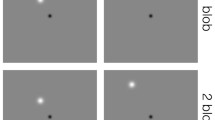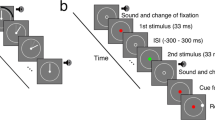Summary and conclusions
-
1.
The equation, phenomenal velocity=phenomenal space/phenomenal time-, v=st, was proven in the following manner. Five cases where variation in the structure of the movement field causes variation in the phenomenal velocity were tested to find out if to the variation in phenomenal velocity corresponding variation in phenomenal time (or phenomenal space) of the movement were to be found. The results of these tests were in close agreement, with the values predicted, from the facts known about phenomenal velocity, on the supposition that the equation held. From this it is concluded that all those structural variations that increase the phenomenal velocity of a movement either increase the phenomenal space or shorten the phenomenal time for equal space correspondingly 2.
-
2.
In far the greater number of cases, the variation is caused in the phenomenal time, and hence it is concluded that impression of duration gained by watching objects in visual movement fields is conditioned by the properties of the field in which the movement occurs.
-
3.
These variations in the flow of phenomenal time are not isolated cases which could be explained as illusions, but are continuous variations conditioned by practically any change in the structure of the movement field.
-
4.
Time where there is movement (filled time) is on the whole phenomenally longer than time marked off by disparate stimuli (unfilled time). This ratio varies, however, in accordance with the structure of the field in which the movement (filled time) occurs.
Zusammenfassung
-
1.
Da früher von uns bewiesen wurde, daß die phänomenale Geschwindigkeit nicht in einfacher Weise von der Reizgeschwindigkeit abhängt, daß also phänomenale Geschwindigkeit nicht proportional dem Quotienten Weg/Zeit ist, wenn Weg und Zeit im physikalischen Raum der Reizbewegung gemessen werden, so wurde die Hypothese aufgestellt, es sei phänomenale Geschwindigkeit gleich dem Quotienten phänomenaler Weg/phänomenale Zeit v=s/t. Die Richtigkeit dieser Gleichung wurde auf die folgende Weise bewiesen: 5 Fälle, in denen eine Variation der Struktur des Bewegungsfeldes eine Variation der phänomenalen Geschwindigkeit bewirkt, wurden herausgegriffen und daraufhin untersucht, ob in ihnen der Geschwindigkeitsveränderung entsprechende Veränderungen der phänomenalen Zeit, bzw. des phänomenalen Weges auftreten. Diese Versuche verliefen positiv. Quantitativ stimmten die gemessenen Werte mit den Werten überein, die wir unter Voraussetzung der obigen Gleichung aus dem früher festgestellten Verhalten phänomenaler Geschwindigkeiten berechnet hatten. Daraus folgt, daß alle die Strukturfaktoren, die die phänomenale Geschwindigkeit vergrößern, entweder den phänomenalen Weg vergrößern oder die phänomenale Zeit verkürzen.
-
2.
In der überwiegenden Zahl der Fälle ist die Veränderung der phä-nomenalen Zeit die Ursache der Veränderung der phänomenalen Geschwindigkeit. Daraus schließen wir, daß der Eindruck der Dauer, den wir bei der Betrachtung bewegter Objekte gewinnen, von den Eigenschaften des Feldes abhängt, in denen die Bewegung stattfindet.
-
3.
Diese Veränderungen im Fluß der phänomenalen Zeit sind nicht isolierte, als bloße Täuschungen erklärbare Fälle. Vielmehr lassen sich stetige Veränderungen der phänomenalen Zeit durch fast beliebige Veränderungen in der Struktur des Bewegungsfeldes bewirken.
-
4.
Die Zeit einer Bewegung (ausgefüllte Zeit) ist im ganzen phä-nomenal länger als Zeit, die von zwei Grenzreizen markiert wird (leere Zeit). Dieses Verhältnis hängt aber natürlich von der Struktur des Feldes ab, in dem die Bewegung abläuft.
Similar content being viewed by others
Author information
Authors and Affiliations
Additional information
This investigation was undertaken while the writer was a National Research Fellow in the Biological Sciences. I wish to thank Prof. Köhler and the staff of his institute for the scientific resources put at my disposal. To Prof. Köhler I am also indebted for many helpful suggestions concerning the preparation of the manuscript. To Mr. Wiehe and Mr. Calavrezo I am indebted for the time that they gave as subjects and for many suggestions during the experimental work.
Rights and permissions
About this article
Cite this article
Brown, J.F. On time perception in visual movement fields. Psychol. Forsch. 14, 233–248 (1931). https://doi.org/10.1007/BF00403874
Received:
Issue Date:
DOI: https://doi.org/10.1007/BF00403874




